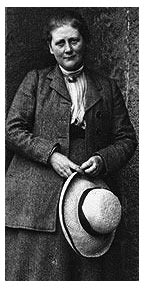
This week we will revisit naturalist and author Beatrix Potter and her magical creations. In 2014 I wrote an article about her, but a friend gave me a book recently entitled “Beatrix Potter’s Gardening Life,” and there is much more to tell about her enchanting life.
Beatrix was born July 18, 1866 at No. 2 Bolton Gardens in London. Her parents had become wealthy in large part because her father, Rupert, had made his fortune in Manchester’s cotton industry.
Nurse MacKenzie and Beatrix would walk along the shaded paths to the Royal Horticultural Society’s Gardens winding through shubberies, around lawns, and alongside flowerbeds. On concert days, musicians played from cast iron bandstands.
Her brother, Bertram, was born when Beatrix was almost six and he would come to enjoy the walks. It was a place where fashionable society strolled. Situated across from Kensington Gardens, both children explored the Flower Walk, playing under Nurse MacKenzie’s watchful eye.
Beatrix’s love of gardening thus began in childhood. The family enjoyed vacations to the British countryside. It was in the gardens of her youth that Beatrix, shy and solitary, joined the gardeners when they tended to the family plots.
She had a menagerie of mice, frogs, snails, lizards, birds, a dog, a dormouse named Xarifa, a hedgehog, a bat and of course, rabbits. Both children were indulged. Beatrix first gardened with her pencil and paintbrush. Her early sketches were enchanting.
Her vivid sketches and watercolors were contained in illustrated letters to her friends and their children. One featured the bunnies Flopsy, Mopsy, Cottontail, and Peter. Those rabbits eventually became her first children’s book “The Tale of Peter Rabbit and Mr. McGregor’s Garden.”
From 1871 to 1881 the family sojourned in the forested hills near Dunkeld, Scotland on the western side of the broad River Tay. Beatrix recalled Dalguise as “beautiful, home sweet home.” She made her own little gardens, fencing tiny enclosures and tending to the plants. However, in 1882, when Beatrix was 16, her father was unable to renew the lease for Dalguise.
With her paintbrush and her pen, Beatrix captured the picturesque gardens of her youth. In one journal entry she recalled that she “itemized sea pinks, a dwarf creeping willow and a spotted-leaved orchid.” She purchased a 34-acre working farm in England’s Lake District. She was 39 years old. Her style was romantic and unpretentious.

Beatrix married William Heelis in 1913 when she was 47. Her parents objected by saying that he was beneath her. Both nature lovers, they accumulated more than 4,000 acres and eventually willed them to the National Trust conservation group.
The cowslips, dahlias, gooseberries, hollyhocks, phlox, peonies, snowdrops and fruits that she grew created a cottage garden of year-long color and variety. Her Hill Top Farm roses grew in profusion and were beloved for their perfume, as well as colors.
She studied 50 species of fungi for 12 years and painted mushrooms, lichens, and pansies in her sketchbooks. Decades after her death, a mycologist, W.P.K. Findlay, used her paintings to illustrate his book Wayside and Woodland Fungi.
December 22, 1943 weakened from influenza and bronchitis, her heart stopped. She was 77 years old. Her ashes were spread in an undisclosed location in Sawrey by her friend, Tom Storey. She would merge with the soil that had nourished her life-long. Her husband, William, died 18 months after her death.
Beatrix left a legacy of land as well as words and pictures. Her gardens frame Hill Top Farm and it welcomes visitors. The gardens are a living link to an outstanding naturalist and gardener.

